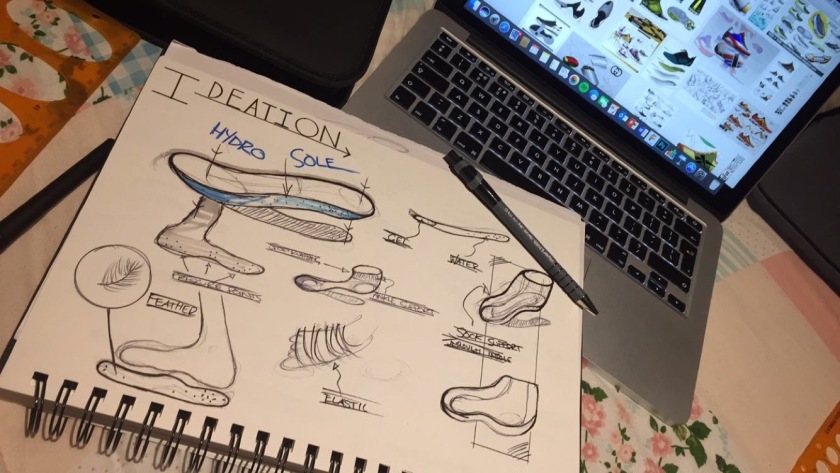
Here is a brief image showing my ideation process. I have explored ideas with water, elastics, feathers and other elements.

Here is a brief image showing my ideation process. I have explored ideas with water, elastics, feathers and other elements.
For my primary research I firstly went on to make a survey open to the public on social media
I then wondered around Cardiff City Centre to observe how people walk on a day to day basis. What I found was quite extraordinary. I found that 4/10 people walk by planting their outside of their foot on the ground before the surface out of the foot. From this observation I could calculate new pressure points of the foot whist people walk.
For my secondary research, I looked into a number of different factors that may affect having comfortable feet whilst walking. The first thing I looked into was products on the market and analysed their characteristics.
Dunlop Gel Insole
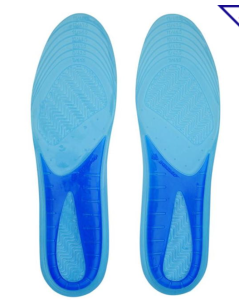
Keep your feet comfortable in the Dunlop Perforated Gel Insoles; featuring breathable perforated sections across the forefoot and heel combined with a soft gel design to help cushion the foot.
> Cushioned insoles
> Perforated strips
> Gel cushioning
> Dunlop logo
> Cut to size
> Feet freshness antibacterial technology
One of downfalls of this product is that its cut to size, therefore there’ll be a lot of wastage, therefore, this insole isn’t sustainable.
Dunlop Pro Gel Insole
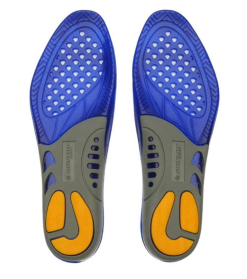
The Dunlop Gel Insole benefit from ODRFRESH for a longer lasting freshness and lightweight and slim design, whilst the Gel arch and gel impact zone offers greater comfort and support.
> Mens Insole
> ODRFRESH
> Lightweight and slim design
> Gel impact zone
> Gel arch support
2 downfalls of this product is that the sizes are already cut but there may be wastage in stock. Also it has an arch support but every customer has a different arch support and it is not relevant to every customer.
During my research on orthotics, I looked into the good and points of orthotics and what I found was extremely interesting.
“Readers often tell me that they think they “might need orthotics,” but they rarely know more than that. The idea is based on an uncertain hunch that something about the way they walk and run can be fixed with a wedge of just the right shape under their feet — which is all orthoses amount to, even the fanciest ones.
Custom foot orthoses or orthopedic footwear or modifications can be really helpful … but mostly for specific, technical, and medical reasons.1 Meanwhile, there are many unscrupulous and shoddy suppliers of these products who will prescribe them for almost any problem — or none! — and the science is complex and incomplete. It is nearly impossible for consumers to know if they actually need any of these products, or where to get an expert prescription and a quality product.”
“A lot has to fall into place before orthotics can possibly work. Even if you do have a biomechanical glitch at the heart of your RSI:
You must have a diagnosable biomechanical problem, probably something really glaringly obvious, because anything more subtle and you’ll probably get different diagnoses from different professionals.
The diagnosed problem must be relevant to your injury. This usually has to be a shot in the dark, because most RSIs are not clearly associated with any known biomechanical problem.
The problem must then be correctable at least in principle. Quite a few problems simply cannot be fixed by orthotics. It depends on the problem.
Assuming all of the above work out, you will still need to get the correct prescription, properly made.
If you can’t tick off one of those, the game is up: orthotics aren’t going to work out. It all adds up to a very long shot.
And yet orthotics could still be worth trying — particularly if you do have a fairly obvious biomechanical problem. Good orthotics are a reasonably good way of trying to “tinker” with any gait or postural dysfunction that may have contributed to your pain in the first place. For instance, unusually high arches are a plausible factor in runner’s knee.”
From discovering these points, It’s obvious that orthotics is a very complex thing and its more than just rocket science. I know many people who are prescribed with orthotics and from this research, It tells me that the people who are being prescribed, may actually don’t need to be prescribed with orthotics. Is it possible to create an accessory like a swiss army knife and solve all the problems in one? This way, what ever the problem the customer may have, this accessory will never fail.
Shoes that are not ergonomic for you, especially if your work requires you to stand for long hours:
By reflecting on this piece of research, I can see more areas to target in my ideation process. High heals, wrong sized shoes and lack of arch support are great examples to uncomfortable feet.
I have decided to look into comfortable feet as my problem in everyday life. From working in a local sports direct store on the shoe department, I found it’s very important to have comfortable feet whether you’re walking the dog or playing football. I found that customers always had a problem with footwear… “Would you like to try a gel insole in that shoe?” that would be the question I would have to ask day in day out, but no, that is not always the answer to having comfortable feet. Every customer has different needs whether it’s the arch of their foot is the problem or the ball of their foot is giving them aches. Looking at existing products on the market at the moment, I feel they don’t meet all the required needs of the customers. Therefore I feel there is a gap on the market to come up with an all new solution to comfortable feet instead of the everyday ‘gel’ or ‘memory foam’ insole.
From discovering this problem, I then went onto making a spider chart of all the problems around the words comfortable feet.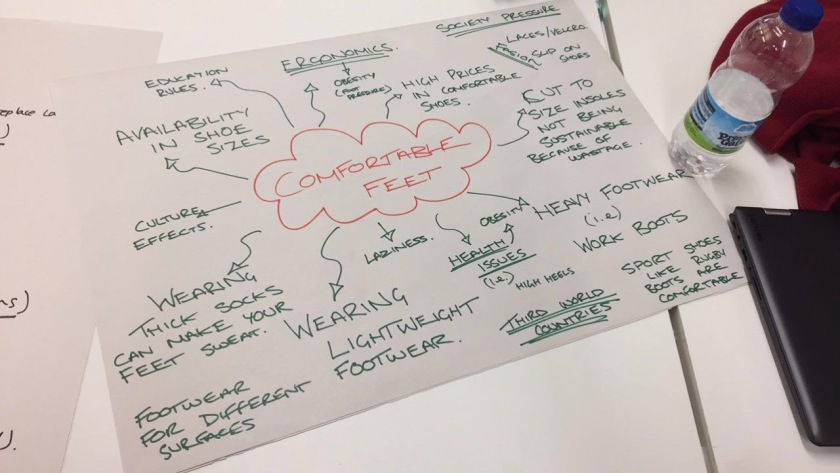
These were the problems I felt may be a background to the problem of having comfortable feet.
The problems below, I felt were the biggest issues:
Results of the research coming soon…
During a design for sustainability lecture I had last week, it was interesting to see the problems we have with sustainability whether it to be around us every day or a problem within a product itself.
After this lecture, I have recently been researching into sustainability, for example the work of Leyla Acaroglu:
At 9:50 Layla talked about that energy wastage isn’t always a problem within the product itself, it’s how we use the product is where we get most of energy wastage. This information has made a huge impact on how I think about solving unsustainable problems. It’s not always about making vast improvements to products which most times result in huge costs that can be avoided, it’s sometimes about how people use products and how we can change peoples mperception or and how we can implement this.
For the discovery process, I used Cardiff for my centre of focus, I done numerous of comparisons of the surrounding area including Taff Trail v Western Avenue for transportation, Llandaff Fields v Bute Park for recreation, Tesco for consumption and local businesses for the economic side of sustainability.
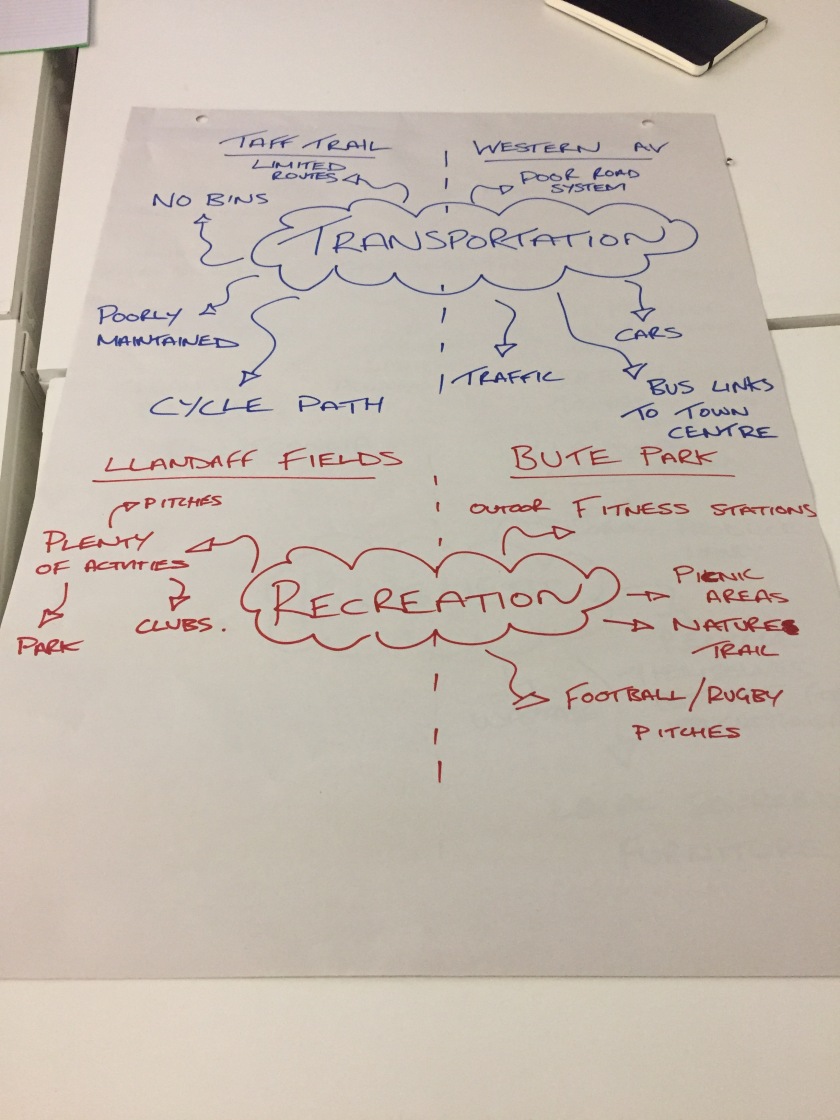 Transportation
TransportationTaff Trail v Western Avenue
During my walk along western avenue the first sign of unsustainability was the traffic. Many cars, bikes, vans pass along this road every day and causes so much build up on rush hour times. Is poor road layout to be blamed? Maybe, but the fact is, billions of people choose cars over a more sustainable choice of transport like riding a bicycle to work and some would say it’s not improving.
Stepping onto the Taff Trail was a complete different world to walking along the Western Avenue. The first thing I noticed was a wide cycle path with many walkers, cyclists and runners using this trail. But one thing that really annoyed me, was the lack of bins, this encouraged people to litter and as a result, the path wasn’t very clean.
Llandaff Fields v Bute Park
During the walk through these parks, in my opinion there wasn’t much difference with regards to sustainability. Both parks included many fields for sports such as football and rugby, outdoor fitness stations, picnic areas, nature trails and much more.
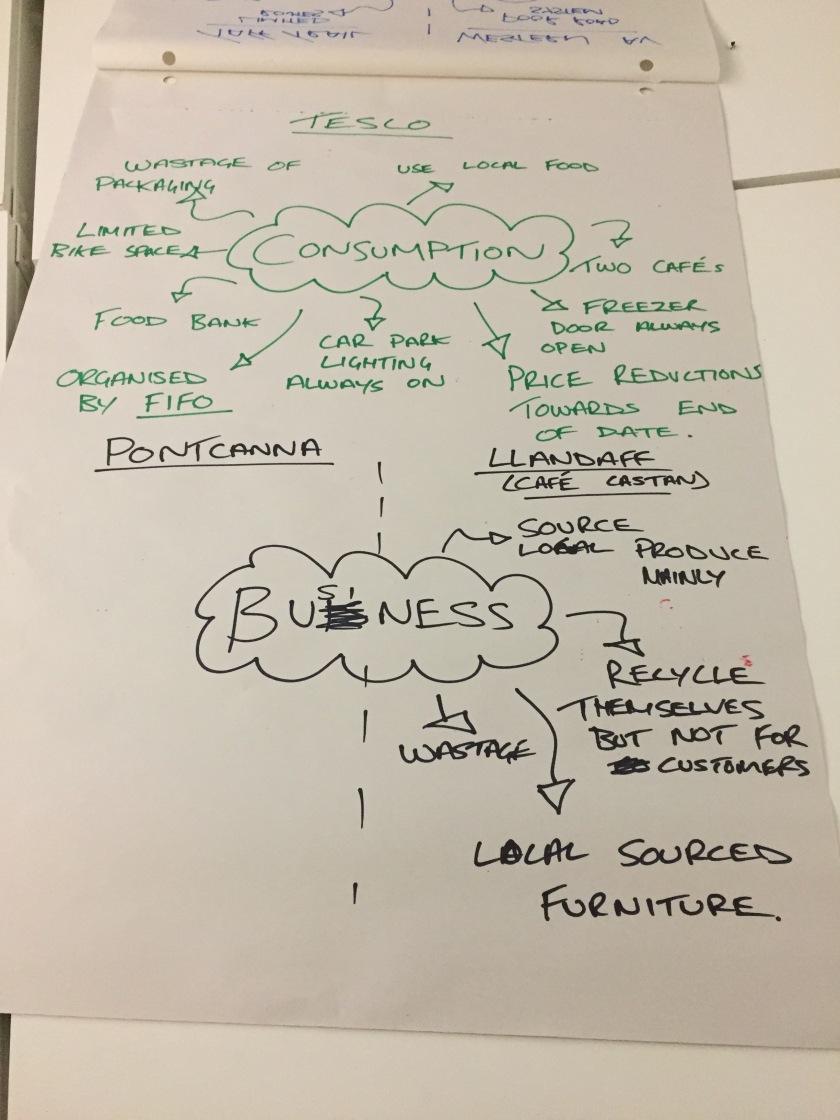
Walking around Tesco and interviewing staff, I found many reasons for unsustainability but also some were very sustainable. First thing that I noticed was the lights in the car park. Lights are arguably one of the main reasons for energy wastage and every single light in the car park was turned on in the middle of the day, this is clearly unsustainable.
A food bank was included in the store and it was great to see that it was full and also I noticed that this store use local produce which is very sustainable.
A local cafe that I went into was a small friendly family run business, the store used all local produce and also local sourced furniture which was nice to hear.
One thing I got from this research was that the world isn’t in a very good state at the moment and there are many problems for product designers to try to solve. As product designers, we have to be more sustainable and ideate around the word sustainable.